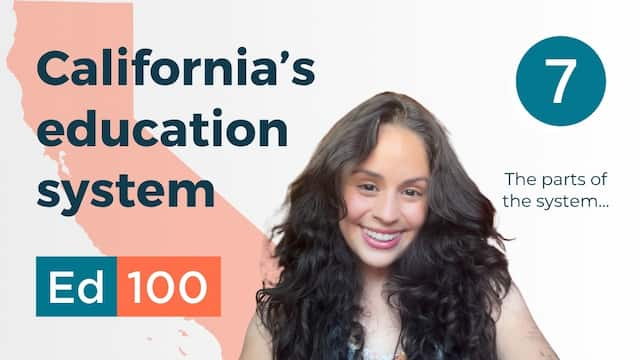
How does the California education system work?
In This Lesson

Why does the state control education?
What are the state’s responsibilities for education in California?
What is the California Education Code?
What does the State Board of Education (SBE) do?
How can our district get a waiver from California regulations?
What does the Superintendent of Public Instruction (SPI) do?
What does the California Department of Education do?
What is the Commission on Teacher Credentialing (CTC)?
How has California education policy changed in recent years?
▶ Watch the video summary
★ Discussion Guide
This lesson is the first in a series that describes the education system in California. Buckle up. The education system is complex, partly because of its sheer size, but also because it serves many competing interests and involves many organizations. Let's start with what might seem like an easy question: Who's in charge of public education?
The US Constitution makes no mention of public education whatsoever. That means each state has considerable power when it comes to education laws. The constitutional provisions relating to education vary a lot from one state to the next.
The original constitution of California said very little about education — it merely directed the legislature to “provide for a system of common schools by which a free school shall be kept up and supported in each district at least six months in every year…” This is such a weak direction that it almost seems to pass the buck to school districts, but a 1991 ruling by the California Supreme Court affirmed the main point: the state is ultimately responsible for education — no ifs, ands or Butts.
California's constitution has been massively amended and extended since 1849, notably through ballot measures passed by voters.
The state is ultimately responsible for education
State government exerts considerable power over public education because, well, the state controls most of the money. (See Chapter 8 for more on that.) Through laws and regulations, the state touches nearly every facet of school operations. Public education is a very big part of what state governments exist to do, so the Education Code is huge.
State government exerts power over education because, well, it controls most of the money.
For your bedtime reading pleasure, California School Law summarizes the state’s education laws (the Ed Code) in a comparatively svelte 600 pages. (You're welcome.)
It's breezy to say that "the state" is responsible for education. In practice, it consists of many distinct entities and organizations.
What is the role of the Governor in education?
As chief executive officer, state governors wield considerable power in the education system, including the power to veto legislation, appoint leaders and drive the budget process. Education is the single largest function of government in California, as in most states, roughly the size of all health and human services functions combined.
California's constitution requires the state budget to be balanced each year. Supported by the state Department of Finance, the Governor's office plays a central role in working with the legislature to make tradeoffs.
What does the State Board of Education do?
The State Board wields significant power, including the power to grant waivers.
The governor wields power in the education system partly by appointing members to the State Board of Education (SBE), an 11-member governing entity with specific authority and responsibilities. Among other things, the SBE is responsible for approving the state’s academic standards, tests, and guidance related to instructional materials. Since 2013, the legislature has also directed the State Board to develop regulations for the Local Control Funding Formula (LCFF), which governs how funds flow from the state to school districts.
The California education code is permissive, which means that school districts are free to take actions unless they are specifically prohibited. Even if something is prohibited, that's not necessarily the end of the story because the State Board of Education has the power to award waivers. If some part of the Ed Code is standing in the way of a plan to improve your school, contact the staff of the State Board for advice about the process.
What does the California Department of Education do?
The state Department of Education (CDE) administers and enforces state and federal education laws. It also provides technical assistance to school districts and collects, analyzes, and disseminates data about the school system. The CDE website is a bit challenging to navigate, but it offers a wealth of raw information for the determined sleuth.
The CDE faces many challenges in carrying out its broad mission. According to research undertaken as part of the 2018 Getting Down to Facts II effort, California's department of education is quite small in comparison to other states, which left it with "limited in-house subject-matter expertise." (Note: This type of research is very difficult to replicate — let us know if you hear of a more recent study!)
Among its challenges, the CDE tends to offer relatively low salaries for state-level positions. According to the GDTFII study, "One challenge to attracting and retaining subject-matter experts arises from lower average salaries in the CDE than in high enrollment county and district offices."
What does the Superintendent of Public Instruction do?
The State Board of Education is the governing body for the California Department of Education (CDE), but it doesn't appoint the head of the department. Instead, the state constitution assigns that role to the Superintendent of Public Instruction (SPI), a non-partisan position elected by the voters of California. This murky constitutional authority is fairly rare — only six other states have a similar office.
Although the SPI has limited power to set policy, the officeholder often serves as a spokesperson and advocate for policy changes. For example, in 2023 the Superintendent of Public Instruction used a timely donation to argue that California ought to require high school students to receive instruction in personal finance.
Learn much more about the role of the Superintendent of Public Instruction in our blog.
What is the Commission on Teacher Credentialing?
The California Commission on Teacher Credentialing (CTC) sets standards for the programs that prepare teachers. Operating independently of the CDE, the State Board, and the Superintendent of Public Instruction, it oversees the credentialing process for educators. Except for the Superintendent of Public Instruction, the members of the CTC are appointed by the governor. Representatives of the state’s systems of higher education also participate as ex-officio members.
The state is a "many-headed beast"
The state is ultimately responsible for providing students with an education, but the California constitution is mushy about what "the state" means. There have been times when the governor, legislature, and Superintendent of Public Instruction have disagreed about education policy. In these times, state governance of education can become a “many headed beast.” Prior to the Brown administration, the beast had yet one more head, a governor-appointed Secretary of Education. A cohesive group of leaders in California, all Democrats, has seemed to tame the beast since 2010. It still has many heads, but they stopped biting one another.
Alignment
During the years of recovery from the Great Recession, the state-led parts of California's education system went through a major remodel. Mike Kirst, the former president of the California State Board of Education, is widely viewed as a lead architect of this remodel, which involved hard-fought changes in standards, curriculum, assessment, finance and more. He explained the vision for "alignment" in this short video: (click to view in new window)
At the end of 2018, virtually all of the people who held the key state leadership positions for California's education system simultaneously left office, were termed out, or retired. In February of 2019, Governor Newsom appointed Linda Darling-Hammond, an experienced education leader, to replace Kirst as president of the State Board of Education.
But wait, you ask, isn't the federal government also critically involved in education? Ah, yes. That is the subject of the next lesson.
Updated July 2025.
CHAPTER 7:
And a System…
-
And a System…
Overview of Chapter 7 -
The Role of State Government in Education
California’s Constitutional Responsibility -
The Federal Government and Education
Small money, Big Influence -
School Districts in California
What do School Districts Do? -
County Offices of Education
Oversight and Regional Services -
Teachers' Unions in California
What do Teacher Unions Do? -
Ballot Initiatives and Education
California's Initiative Process and How It Affects Schools -
Who Influences Education?
Politics, Philanthropy and Policy -
Accountability in Education
Who Monitors the Quality of Schools? -
What to Do with Failing Schools
Interventions and Consequences in California -
The LCAP
Annual Plans for California School Districts
Related
Sharing is caring!
Password Reset
Search all lesson and blog content here.
Login with Email
We will send your Login Link to your email
address. Click on the link and you will be
logged into Ed100. No more passwords to
remember!















Questions & Comments
To comment or reply, please sign in .
Carol Kocivar December 5, 2025 at 3:36 pm
Putting the Department of Education under the governor would clarify responsibilities, one recommendation said.
The report TK–12 Education Governance in California: Past, Present, and Future examines the history of California’s education governance system, analyzes the state of the current system and its effectiveness across six key dimensions, and offers recommendations for realigning roles and responsibilities to create a more coherent education governance system in California. Education governance encompasses the mechanisms through which decisions are made, responsibilities are distributed, and accountability is maintained within the public education system.
https://edsource.org/2025/pace-report-education-overhaul
Jeff Camp December 14, 2018 at 2:44 pm
Carol Kocivar April 23, 2016 at 4:42 pm
Find out more....
http://www.ecs.org/ec-content/uploads/2016-Constitutional-obligations-for-public-education-1.pdf